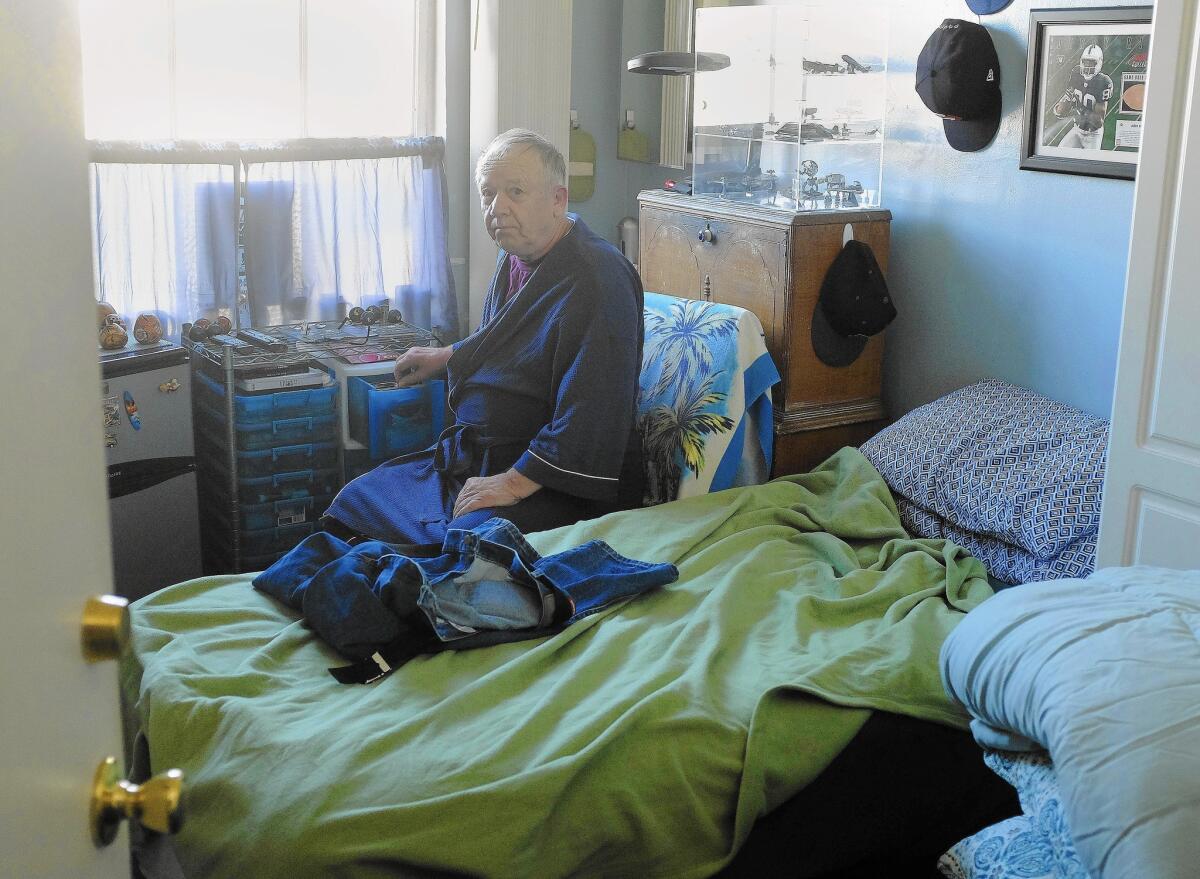Disappearance of SRO hotels playing even larger role in San Diego’s homelessness problem

- Share via
Reporting from San Diego — The disappearance of single-room-occupancy hotels here, considered a key factor in the city’s worsening homeless problem, has been more severe than city officials thought.
A new survey has found that the number of remaining SRO rooms, the lowest rung on the housing ladder above being homeless, has shrunk from 14,000 in the late 1980s to fewer than 3,900 now.
And with downtown in the middle of a construction boom, city officials and community leaders say they expect even more of the bargain-rate hotels to be demolished in coming years.
They also say the sharp reduction in SRO rooms has played a role in San Diego’s steady climb up the national rankings for homelessness. Since 2007, the city has risen from 12th in the nation to fourth.
“I have never seen this many people on the streets in the 30 years I’ve been doing this, and the elimination of the SROs is a major component,” said Bob McElroy, chief executive of the nonprofit Alpha Project. “Those were the only place for lots of low-income seniors, disabled and people with mental health issues, and now they’re gone.”
Other U.S. cities, most notably San Francisco and Chicago, have experienced similar problems with SROs, which are sometimes called “residential hotels,” being demolished as part of gentrification and urban revitalization.
Steve Pollack has been scrambling to find an SRO room because downtown’s 44-room Star Hotel, his residence for the last three years, will soon be demolished to make way for a high-rise housing project.
“A lot of the people living in the Star are going to become homeless because it’s so hard to find places now,” said Pollack, 51. “I’ve been looking all over, but they won’t call you back. You’ve got to meet them in person so they can look and see how you are.”
A typical SRO tenant receives $800 to $900 a month in Social Security and pays well over half of that for a room, which is usually quite small and almost never includes a bathroom or kitchen.
City Councilman Todd Gloria said it’s important to maintain as many SRO rooms as possible, but he said better long-term solutions to homelessness would be higher-quality, subsidized housing projects with on-site social services for tenants.
“I don’t want anyone to get romantic about SROs,” he said. “They are highly valuable in our overall housing inventory, but the truth is many are affordable for two probably bad reasons: The rooms are often the size of a walk-in closet and they are in really old buildings that haven’t been well-maintained.”
Until more quality affordable housing can be built, Gloria said, the city’s only choice is to preserve the SROs.
“It’s certainly better than the street, no question,” he said.
City officials were concerned about SROs potentially disappearing in the 1980s, when downtown’s Horton Plaza-fueled renaissance began.
The City Council passed an ordinance in 1987 requiring developers that convert single-room-occupancy units into other kinds of projects to pay hefty fees to help replace them. But the law hasn’t been as effective as hoped, with many developers granted exemptions and the city struggling to build projects with the fees collected.
Some SROs have been demolished to make way for civic projects, with a key example being the iconic Hotel San Diego on Broadway being razed in 2006 to make way for a new federal courthouse.
The problem has become particularly bad since the state eliminated redevelopment districts in 2011. Those districts had been required to spend 20% of their revenues on low-income housing, a key source of funding that was often combined with fees collected from developers.
A couple of recent projects could serve as models for the future.
The Hotel Metro SRO has been replaced by Alpha Square, a subsidized downtown project that still has small rooms but eliminated communal bathrooms by including one in each unit.
And downtown’s Hotel Churchill is being remodeled to serve as a more modern, upscale version of an SRO, also with private bathrooms.
The two projects are relatively costly, with the Churchill renovations expected to cost $20 million for 72 units — nearly $300,000 per unit.
Both projects fit the federal government’s “housing first” model for ending homelessness, but neither suffers from the typical shortcomings of SROs: deterioration and substandard amenities.
In addition, the presence of on-site social services at both projects has created optimism that SROs can be built outside downtown, where land costs make such projects difficult to finance.
“Downtown real estate is really expensive,” Gloria said. “If we can stretch money further by building in other communities willing to accept these projects, then we should do that. It’s a better return for the taxpayers and it yields more units.”
In addition, keeping the services on-site may decrease neighborhood loitering by residents, which can reduce resistance from residents.
david.garrick@sduniontribune.com
Twitter: @UTDavidGarrick
Garrick writes for the San Diego Union-Tribune.
More to Read
Sign up for Essential California
The most important California stories and recommendations in your inbox every morning.
You may occasionally receive promotional content from the Los Angeles Times.













